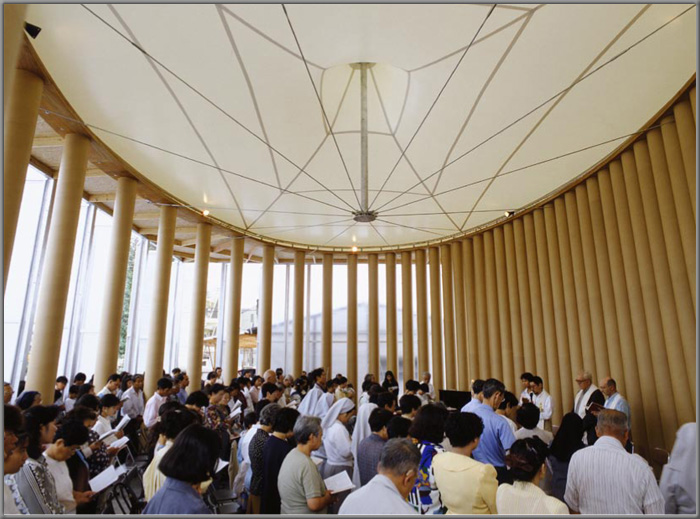Home > Highlighting JAPAN > Highlighting Japan DECEMBER 2011 > Paper Pipes Provide Lifeline
Highlighting JAPAN
COVER STORY: Pillars of Strength
Caption: The community center (Paper Church) in Kobe was built by church volunteers whose house of worship was destroyed by the Great Hanshin-Awaji Earthquake in 1995. Materials were donated by a number of companies, and construction was completed in only five weeks by the 160 volunteers.
Credit: COURTESY OF HIROYUKI HIRAI
Paper Pipes Provide Lifeline
Architect Shigeru Ban has gained high recognition worldwide for his use of structures made of paper pipes in efforts to provide support for people affected by disasters. Here we introduce his architectural works and activities.

Shigeru Ban
Though Ban has often expressed the warmth of wood in his designs, since the 1980s he has been interested in paper as an architectural material to replace wood. He has studied and experimented with paper pipes, first using them in support efforts for people affected by the Great Hanshin-Awaji Earthquake which struck in January 1995. Ban frequently visited Kobe after the earthquake and built a community hall (commonly known as the Paper Church), which contains fifty-eight five-meter paper pipes supporting a roof made of cloth on the site of a church that burned down. (The Paper Church was transferred to a village damaged by the large-scale earthquake that hit Taiwan in 1999, where it is now used as a community hall.)

Japanese and Chinese universities cooperated to design and construct paper-tube-structured temporary classrooms at an elementary school struck by the Sichuan earthquake in May 2008.
Credit: COURTESY OF LI JUN
Ban has engaged in numerous support efforts using paper pipes in times of disaster, including the shelter that the United Nations High Commissioner for Refugees offered to Rwandan refugees in 1999, temporary houses for those affected by the earthquakes in Turkey in 1999 and India in 2000, and temporary school buildings for elementary schools destroyed in the Great Sichuan Earthquake in 2008.
Ban has actively taken part in support activities following the Great East Japan Earthquake as well. He installed partitions made of paper pipes at evacuation centers, which allow people there to maintain a level of privacy. He also helped to build three-storied temporary housing made by combining existing cargo containers.
In recognition of these activities, Ban was awarded the Auguste Perret Prize on September 27 at UIA 2011 in Tokyo (see pp. 18–19). The jury's review stated, "Shigeru Ban carries international respect for applying his ability in technology in architecture to not only serving the more affluent users of architecture but also to a creative exploration of shelter using paper tubes and membranes for disaster relief. He achieves this without compromising functionality or aesthetics."
Ban explained why he actively takes part in disaster relief activities: "People die in natural disasters mostly from manmade causes. People die in earthquakes because buildings collapse. For this reason, I believe we architects are heavily responsible for helping those affected by disasters."
© 2009 Cabinet Office, Government of Japan






